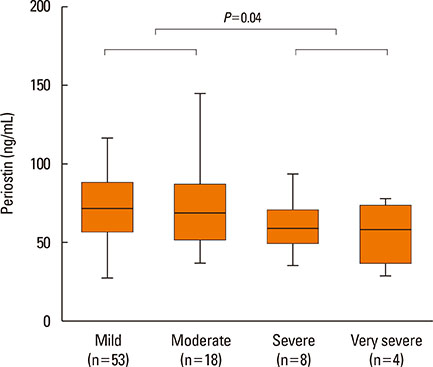Allergy Asthma Immunol Res.
2016 Sep;8(5):457-460. 10.4168/aair.2016.8.5.457.
Periostin and Interleukin-13 Are Independently Related to Chronic Spontaneous Urticaria
- Affiliations
-
- 1Department of Dermatology, Hallym University Dongtan Sacred Heart Hospital, Hwaseong, Korea.
- 2Division of Medical Biochemistry, Department of Biomolecular Sciences, Saga Medical School, Saga, Japan.
- 3Department of Laboratory Medicine, Saga Medical School, Saga, Japan.
- 4The Shino-Test Corporation, Sagamihara, Japan.
- 5Department of Pharmacology and SBRI, Sungkyunkwan University School of Medicine, Suwon, Korea.
- 6Department of Pulmonology and Allergy, Hallym University Dongtan Sacred Heart Hospital, Hwaseong, Korea. mdqueen@hallym.or.kr
- KMID: 2295155
- DOI: http://doi.org/10.4168/aair.2016.8.5.457
Abstract
- Chronic spontaneous urticaria (CSU) is a complex idiopathic disease of the skin with various cellular infiltrations. Although mast cells are key effector cells in the pathogenesis of CSU, CD4+ T helper 2 cells also have particular roles in the development and maintenance of CSU. Periostin is known as a downstream molecule of interleukin (IL)-4 and IL-13, key cytokines of type 2 immune responses. In this study, we examined periostin and IL-13 levels in the sera of patients with CSU (n=84) and healthy normal controls (NCs, n=43). Periostin levels were significantly lower in the CSU group than in NCs (71.4±21.8 vs 85.1±22.4 ng/mL, P=0.04). Periostin levels were also lower in the severe CSU group than those in mild CSU (59.7±18.0 vs 73.4±22.0 ng/mL, P=0.04). However, IL-13 levels were significantly higher in patients with CSU than in NCs (508.5±51.2 vs 200.7±13.3 pg/mL, P=0.001). In conclusion, periostin and IL-13 may be independently related to the pathogenesis of CSU.
Keyword
MeSH Terms
Figure
Cited by 1 articles
-
Serum Periostin Is Negatively Correlated With Exposure to Formaldehyde and Volatile Organic Compounds in Children
Dong Keon Yon, Jaewoo An, Eun Kyo Ha, Hye Mi Jee, Kenji Izuhara, Junya Ono, Young-Ho Jung, Kyung Suk Lee, Youn Ho Sheen, Heysung Baek, Man Yong Han
Allergy Asthma Immunol Res. 2018;10(6):716-721. doi: 10.4168/aair.2018.10.6.716.
Reference
-
1. Zuberbier T, Aberer W, Asero R, Bindslev-Jensen C, Brzoza Z, Canonica GW, et al. Methods report on the development of the 2013 revision and update of the EAACI/GA2 LEN/EDF/WAO guideline for the definition, classification, diagnosis, and management of urticaria. Allergy. 2014; 69:e1–e29.2. Losol P, Yoo HS, Park HS. Molecular genetic mechanisms of chronic urticaria. Allergy Asthma Immunol Res. 2014; 6:13–21.3. Ying S, Kikuchi Y, Meng Q, Kay AB, Kaplan AP. TH1/TH2 cytokines and inflammatory cells in skin biopsy specimens from patients with chronic idiopathic urticaria: comparison with the allergen-induced late-phase cutaneous reaction. J Allergy Clin Immunol. 2002; 109:694–700.4. Zweiman B, Haralabatos IC, Pham NC, David M, von Allmen C. Sequential patterns of inflammatory events during developing and expressed skin late-phase reactions. J Allergy Clin Immunol. 2000; 105:776–781.5. Ferrer M, Luquin E, Sanchez-Ibarrola A, Moreno C, Sanz ML, Kaplan AP. Secretion of cytokines, histamine and leukotrienes in chronic urticaria. Int Arch Allergy Immunol. 2002; 129:254–260.6. Caproni M, Cardinali C, Giomi B, Antiga E, D'Agata A, Walter S, et al. Serological detection of eotaxin, IL-4, IL13, INF-γ, MIP-1α, TARC and IP-10 in chronic autoimmune urticaria and chronic idiopathic urticaria. J Dermatol Sci. 2004; 36:57–59.7. Takayama G, Arima K, Kanaji T, Toda S, Tanaka H, Shoji S, et al. Periostin: a novel component of subepithelial fibrosis of bronchial asthma downstream of IL-4 and IL-13 signals. J Allergy Clin Immunol. 2006; 118:98–104.8. Jia G, Erickson RW, Choy DF, Mosesova S, Wu LC, Solberg OD, et al. Periostin is a systemic biomarker of eosinophilic airway inflammation in asthmatic patients. J Allergy Clin Immunol. 2012; 130:647–654.e10.9. Masuoka M, Shiraishi H, Ohta S, Suzuki S, Arima K, Aoki S, et al. Periostin promotes chronic allergic inflammation in response to Th2 cytokines. J Clin Invest. 2012; 122:2590–2600.10. Wenzel SE. Asthma phenotypes: the evolution from clinical to molecular approaches. Nat Med. 2012; 18:716–725.11. Izuhara K, Arima K, Ohta S, Suzuki S, Inamitsu M, Yamamoto K. Periostin in allergic inflammation. Allergol Int. 2014; 63:143–151.12. Kou K, Okawa T, Yamaguchi Y, Ono J, Inoue Y, Kohno M, et al. Periostin levels correlate with disease severity and chronicity in patients with atopic dermatitis. Br J Dermatol. 2014; 171:283–291.13. Konstantinou GN, Asero R, Maurer M, Sabroe RA, Schmid-Grendelmeier P, Grattan CE. EAACI/GA(2)LEN task force consensus report: the autologous serum skin test in urticaria. Allergy. 2009; 64:1256–1268.14. Kay AB, Clark P, Maurer M, Ying S. Elevations in Th2-initiating cytokines (IL-33, IL-25, TSLP) in lesional skin from chronic spontaneous ("idiopathic") urticaria. Br J Dermatol. 2014; 172:1294–1302.15. Yang L, Murota H, Serada S, Fujimoto M, Kudo A, Naka T, et al. Histamine contributes to tissue remodeling via periostin expression. J Invest Dermatol. 2014; 134:2105–2113.
- Full Text Links
- Actions
-
Cited
- CITED
-
- Close
- Share
- Similar articles
-
- Clinical perspective on serum periostin in antineutrophil-cytoplasmic antibody-associated vasculitis
- Using Periostin as a Biomarker in the Treatment of Asthma
- No evidence of association between interleukin-13 gene polymorphism in aspirin intolerant chronic urticaria
- Dermographism ( III ): Dermographism in Acute and Chronic Urticaria
- Eczematous Vesicular Rruption and Exacerbation of Chronic Spontaneous Urticaria Associated with Secukinumab



